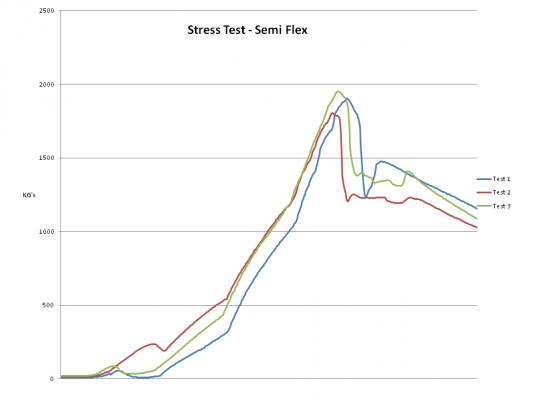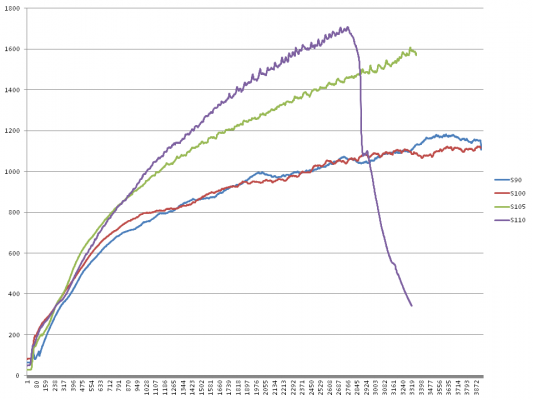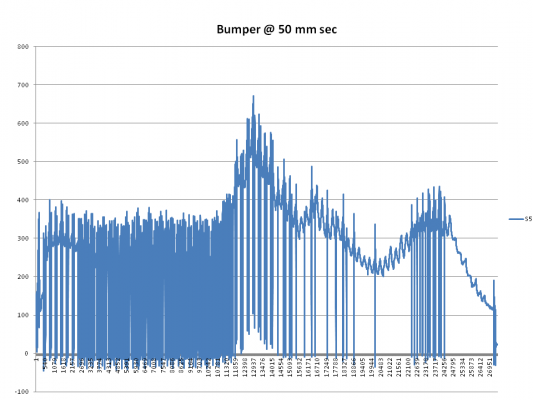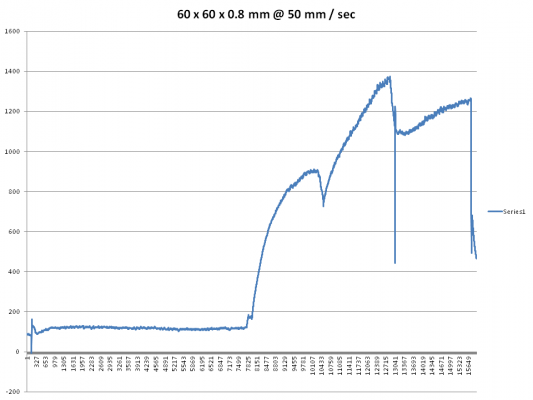Runaway Hysteresis in Bowden tube when printing with flex??
Posted by Arnold Lane 1000
|
Runaway Hysteresis in Bowden tube when printing with flex?? February 10, 2019 11:26PM |
Registered: 8 years ago Posts: 19 |
Hi all
I specialize in printing with flex and provide flexible parts on a commercial basis. Recently I decided to delve into my Bowden Cable set up in order to gather some empirical data to try to understand why some prints fail at lower print speeds while others continue on to completion with no problem even when processed and printed at much higher speeds, I thought I would post my results for those that may find it of interested. I have also included my assumption as to what is going on and invite feedback if you have other theories.
The method: In order to collect data I set up a load cell at the output point of my extruder similar to [www.thingiverse.com] and [airtripper.com]
Observations:
Firstly I calculated the failure point of the system - Graph 1 - In this case with this type of flex filament it was about 1800 - 1950 grams of force generated before failure (The experiment was conducted three times).
I then extruded a continuous length of filament at four different speeds - Graph 2 - The lower three speeds successfully completed the test where the upper purple line breached the failure threshold and would have resulted in print failure.
Thirdly I printed two completely different types of 'things' which were sliced with the same parameters and printed at 50 mm / sec each with very different results.
Thing 1 - A bumper bar for a remote control car [www.thingiverse.com] which contains multiple small sections and lots of retraction. Required force does not exceed 680 grams.
Thing 2 A flat plane square 60 mm x 60 mm x 4 layers. You can distinctively see the 4 layers - The first base layer was printed slow the second and third printed at full speed and the forth printed after a retraction. You can clearly see the increase in required force peaking at 1380 grams. You can also see the effect of retraction on the required force - which is subject for further investigation.
Discussion:
Without going to deep into the detail of the data what I noticed was that long extrusion lines over larger areas significantly increase the required force. This amount of force eventually starts to taper off and move towards equilibrium which is great if this peak is achieved before the failure point.
What I surmise is happening is that over larger ares and as the flexible filament bunches up (i.e hysteresis) more force is required to overcome the extra friction generated, this additional force results in even greater hysteresis being created which then compounds around in circle leading to 'runaway hysteresis' which quickly exceeds the failure threshold.
I quess a take out message would also be when printing with flex the shape of the item is of great consideration when setting slicing parameters.
www.flexwheelextruder.com
I specialize in printing with flex and provide flexible parts on a commercial basis. Recently I decided to delve into my Bowden Cable set up in order to gather some empirical data to try to understand why some prints fail at lower print speeds while others continue on to completion with no problem even when processed and printed at much higher speeds, I thought I would post my results for those that may find it of interested. I have also included my assumption as to what is going on and invite feedback if you have other theories.
The method: In order to collect data I set up a load cell at the output point of my extruder similar to [www.thingiverse.com] and [airtripper.com]
Observations:
Firstly I calculated the failure point of the system - Graph 1 - In this case with this type of flex filament it was about 1800 - 1950 grams of force generated before failure (The experiment was conducted three times).
I then extruded a continuous length of filament at four different speeds - Graph 2 - The lower three speeds successfully completed the test where the upper purple line breached the failure threshold and would have resulted in print failure.
Thirdly I printed two completely different types of 'things' which were sliced with the same parameters and printed at 50 mm / sec each with very different results.
Thing 1 - A bumper bar for a remote control car [www.thingiverse.com] which contains multiple small sections and lots of retraction. Required force does not exceed 680 grams.
Thing 2 A flat plane square 60 mm x 60 mm x 4 layers. You can distinctively see the 4 layers - The first base layer was printed slow the second and third printed at full speed and the forth printed after a retraction. You can clearly see the increase in required force peaking at 1380 grams. You can also see the effect of retraction on the required force - which is subject for further investigation.
Discussion:
Without going to deep into the detail of the data what I noticed was that long extrusion lines over larger areas significantly increase the required force. This amount of force eventually starts to taper off and move towards equilibrium which is great if this peak is achieved before the failure point.
What I surmise is happening is that over larger ares and as the flexible filament bunches up (i.e hysteresis) more force is required to overcome the extra friction generated, this additional force results in even greater hysteresis being created which then compounds around in circle leading to 'runaway hysteresis' which quickly exceeds the failure threshold.
I quess a take out message would also be when printing with flex the shape of the item is of great consideration when setting slicing parameters.
www.flexwheelextruder.com
|
Re: Runaway Hysteresis in Bowden tube when printing with flex?? February 11, 2019 01:25AM |
Registered: 6 years ago Posts: 1,007 |
Sorry, only registered users may post in this forum.



